基于水氮管理与种植结构优化的作物丰产高效管理策略
陈世超,刘文丰,杜太生
基于水氮管理与种植结构优化的作物丰产高效管理策略
陈世超,刘文丰,杜太生※
(1. 中国农业大学中国农业水问题研究中心,北京 100083;2. 甘肃武威绿洲农业高效用水国家野外科学观测研究站,武威 733000)
河西走廊农业生产受到水资源短缺与农业资源利用效率低的限制,制约着该地区的种子、粮食生产与农业可持续发展战略。该研究构建了考虑作物水氮需求量、降雨量、土壤初始含氮量的水氮管理制度优化方法,并结合所构建的考虑空间尺度作物产量与水氮利用效率的多目标种植结构优化方法,为河西走廊制种玉米、大田玉米和小麦制定丰产高效的水氮管理与种植结构调整策略,从而实现作物产量和水氮利用效率的协同提升。结果显示:优化的水氮管理制度相比管理现状可减少单位面积灌水量9.1%~27.3%、施氮量26.6%~50.0%;以作物产量和水氮利用效率最大为目标,以种植面积、产量需求和水氮投入量为约束,调整制种玉米、大田玉米和小麦的种植面积与空间分布,优化后制种玉米和小麦种植面积减少、大田玉米种植面积增加,总种植面积减少4 874.8 hm2,且作物种植空间分布较优化前差异明显;水氮管理与种植结构优化协同作用可以在水氮用量分别减少0.29×109m3和3.36×107kg的情况下,作物总产量提升0.16×109kg,区域灌溉水生产力和氮肥利用效率分别提升0.62 kg/m3和18.97 kg/kg。该研究可以为产粮区和缺水区的作物丰产高效和农业可持续发展提供科学指导与决策参考。
作物;灌溉;优化;种植结构;水氮管理;灌溉水生产力;氮肥利用效率
0 引 言
河西走廊是中国重要的玉米制种基地,丰富的光热资源是该地区成为制种和粮食基地的重要资源保障,年产玉米种子约63万t;同时该区域也是重要的商品粮基地,以甘肃省18%的耕地生产了全省约40%的大田玉米和小麦。然而水资源短缺、水肥利用效率低、农业布局不合理与生态脆弱严重制约着农业可持续发展[1]。面对日益增长的粮食需求,如何优化区域水氮管理制度和作物种植结构,是实现河西走廊制种玉米、大田玉米和小麦丰产高效的关键,也是河西走廊农业可持续发展与生态环境良性循环的必然要求。
优化灌溉施氮制度是提高水氮利用效率和生产率的重要措施[2],已有研究在田间尺度上基于试验与模型对河西走廊制种玉米、大田玉米和小麦丰产高效制定了水氮管理策略。如赵建华等[3-4]基于田间试验发现灌水量为330~450 mm、施氮量为150~225 kg/hm2可以使制种玉米产量、水分利用效率和氮利用效率分别提升13%、20%和32%;Xiao等[5]基于田间试验确定了410~450 mm灌水量和140~180 kg/hm2施氮量可以综合提升大田玉米生产、经济和环境效益;Yang等[6]基于田间试验确定了小麦最优灌水量为274 mm、施氮量为180 kg/hm2,与Li等[7]在河西走廊石羊河流域的优化结果相似。作物对水分与氮素的实际需求量是水氮管理制度优化的基础,并与气候条件与土壤养分相关,存在区域异质性[8]。上述田间尺度的试验与模拟结果可以为区域尺度作物水氮管理提供参考,但如何考虑气候、土壤的空间变异特征从而在区域尺度上为不同作物优化水氮管理制度,还需要进一步研究。
种植结构优化是实现区域水资源与土地资源优化配置的基础,对于水资源短缺、种植结构不合理的地区尤为重要[9]。通过优化区域不同作物种植面积与空间分布,可对水资源、土地资源的合理配置,实现生产效益、环境效益和经济效益的最大化。随着智能算法的发展,种植结构优化方法由灰色分析法、目标权重法等发展到遗传算法[10]、粒子群算法[11]等。Liu等[12]结合SWAT(Soil and Water Assessment Tool)模型和元胞自动机模型优化了黑河中上游地区小麦、玉米、棉花、大麦、油菜和苜蓿的种植结构,实现了作物水分生产力、经济水分生产力和养分水分生产力的协同提升。种植结构优化可以实现水资源的空间优化配置,而与灌溉制度优化相结合则可以进一步提升作物产量和农业资源利用效率[13]。但目前在区域尺度上不同作物水氮管理制度优化与作物种植结构优化的研究仍较少。
因此,本研究以河西走廊制种玉米、大田玉米和小麦为研究对象,以作物产量、灌溉水生产力和氮素利用效率协同提升为目标,考虑土壤养分含量和作物生育期内气候条件,优化不同作物水氮管理制度与种植结构,在确保作物产量的同时减少农业水氮投入量,为河西走廊作物丰产高效与绿色发展提供科学指导与决策参考。
1 材料与方法
1.1 研究区概况
河西走廊位于甘肃省西北部(37°17′~42°48′ N,92°12′~104°20′ E),面积约27万km2,行政区划主要包含武威、张掖、金昌、嘉峪关和酒泉5个地级市共20个县(区)(图1)。河西走廊属于温带大陆性气候,年均气温7.6 ℃,年日照时数为3 000 h,年均降水量为130 mm,年均蒸发量为2 000 mm,且光热资源丰富,有利于农作物生长发育;灌溉农业发达,年产玉米种子占全国大田玉米年用种量50%以上,同时是甘肃省重要的商品粮种植基地和经济作物生产基地。

图1 河西走廊高程和气象站点空间分布图
1.2 数据来源
本文以河西走廊为研究区域,以制种玉米(先玉335)、大田玉米(强盛51)和小麦(永良4)为研究对象。历史气象数据采用“中国区域地面气象要素驱动数据集1979—2018(China Meteorological Forcing Dataset,CMFD)”[14],空间分辨率为0.1°;土壤理化性质采用“世界土壤数据库(Harmonized World Soil Database,HWSD)”[15],空间分辨率为1 km;作物种植面积采用“作物空间分配模型数据集(Spatial Production Allocation Model,SPAM-2010)”[16],空间分辨率为5′,基于河西走廊5个地级市(武威、张掖、金昌、嘉峪关和酒泉)统计年鉴(1979—2018)中各县(区)制种玉米、大田玉米和小麦的种植面积进行校验;县级尺度3种作物单位面积产量、灌水施氮量、种植面积数据取自《甘肃发展年鉴(1979—2018)》和河西走廊5个地级市的统计年鉴(1979—2018);制种玉米、大田玉米与小麦的实测产量数据,来自于甘肃武威绿洲农业高效用水国家野外科学观测研究站和甘肃省农科院张掖节水农业试验站开展的多年不同水氮处理试验数据。鉴于土壤、气候、作物分布数据的空间尺度与分辨率不一致,使用ArcGIS 10.6(ESRI,USA)基于河西走廊区域面数据按区域提取各数据集,使用气候数据处理软件CDO(Climate Data Operators:https://code.mpimet.mpg.de/projects/cdo)中的一阶保守重映射[17]将各数据集重采样至5′的空间分辨率。
1.3 APSIM模型的参数率定与模拟
1.3.1 APSIM-Maize和APSIM-Wheat模块及其参数率定
APSIM(Agricultural Production Systems sIMulator)模型是由澳大利亚农业生产系统研究组(APSRU)开发的可以模拟农业系统生物物理和化学过程机理及其对气候变化响应规律的作物生长模型。其中,土壤、作物与管理模块决定作物可利用水分和养分,进而影响作物的光合速率与生育进程并最终影响产量,因此,APSIM模型可以精确模拟不同水氮管理情景下的作物产量。本文使用APSIM version7.10进行模拟,通过R语言中的CroptimizR程序包[18]在APSIM中构建制种玉米品种并校正关键参数,同时校正大田玉米和小麦的关键参数。为实现区域尺度的模型模拟,使用Python语言编程批量调用APSIM模型,实现区域每个栅格批量输入、模拟、输出。
1.3.2 模型评价指标
采用归一化均方根误差(nRMSE)和确定性系数(2)评价APSIM模型在河西走廊对制种玉米、大田玉米和小麦的适用性。



1.3.3 水氮管理制度优化方法
河西走廊农业生产中目前存在严重的水氮过量施入情况[19]。该区域为灌溉农业,作物生长所需水量主要来源于灌溉水和作物生育期内降水,而所需氮元素主要来自于追施氮肥和土壤初始含氮量。河西走廊地下水埋深平均值约11.7 m,部分地区地下水埋深超过20 m[20]。因此,本研究基于气象与土壤养分数据优化区域尺度3种作物的水氮投入量,模拟中忽略地下水位动态变化。
1)不同作物区域尺度灌水量
作物生育期内灌水量根据作物耗水量和降水量确定。其中,作物耗水量由单作物系数法确定[21]。

式中ET为逐日标准条件(非胁迫)下的作物耗水量,mm;K为作物系数,研究表明作物系数在时间和空间尺度上的变异程度较弱[22],因此在区域尺度上使用统一的K:大田玉米和小麦前期、中期、后期的K使用FAO-56提供的参考值[21],制种玉米前期、中期、后期的K参考Jiang等[23]研究结果。ET0为参考作物蒸发蒸腾量(mm),由于APSIM模型中使用Priestley-Taylor法[24]计算ET0,本研究中也将使用该方法,所涉及的变量均可根据“中国区域地面气象要素驱动数据集1979—2018(CMFD)”数据集获得或计算得到,计算公式为

式中为Priestley-Taylor系数,取值为1.26;为干湿度计常数,kPa/℃;△为饱和水汽压与温度关系曲线上的斜率,kPa/℃;R为植被表面净辐射量,W/m2;为土壤热通量,W/m2。
河西走廊每个栅格内灌水量为

式中Irr、ET和P分别为第个栅格内第(=1,2,3)种作物的灌水量、耗水量和作物生育期内降雨量,mm;为农田灌溉水利用系数,本文取0.53[25]。
2)不同作物区域尺度施氮量
作物生育期内施氮量根据作物吸氮量和土壤含氮量确定。其中,作物吸氮量由作物氮浓度和生物量累积曲线确定。

式中NU为作物吸氮量,kg/hm2;Bio为作物生物量,kg/hm2;N为作物氮浓度,依据Liang等[26]的研究结果,确定制种玉米、大田玉米和小麦成熟期N分别为1.4%、1.1%和1.6%。作物生物量累计曲线基于Logistic曲线确定[27]。

式中GDD为有效积温,℃;Biomax为作物最大生物量,kg/hm2,根据田间实测数据,对制种玉米、大田玉米和小麦分别取值为29 800 kg/hm2[3]、44 532 kg/hm2[28]和26 379 kg/hm2[6]。因此,河西走廊每个栅格内施氮量为

式中Nfer、NU和NS分别为在第个栅格内第种作物的施氮量、吸氮量和土壤含氮量,单位均为kg/hm2;为氮肥利用效率,本文取0.75[29]。土壤含氮量数据来自世界土壤数据库(Harmonized World Soil Database,HWSD)数据集。
1.4 种植结构优化模型构建与求解
1.4.1 种植结构优化模型构建
1)目标函数
①作物产量最大目标函数为

式中=1,2,3分别对应制种玉米、大田玉米和小麦;Y为在第个栅格内第种作物的单位面积产量,kg/hm2;A为在第个栅格内第种作物的种植面积,hm2;sum为研究区内3种作物总产量,kg。
②灌溉水生产力、氮肥利用效率最大目标函数


式中WPIaver和NUEaver分别为研究区域灌溉水生产力(kg/m3)和氮素利用效率(kg/kg)的平均值。
2)约束条件
①作物种植面积约束
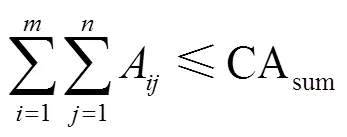
式中CAsum为3种作物种植总面积现状,hm2。参考Lalehzari等[30]的研究成果,设置优化后每个栅格内3种作物的种植面积的变化幅度均小于30%,即

当CA=0时,上述约束条件无效,因此设置以下约束

式中CA为在第个栅格内第种作物的种植面积现状,hm2;min和max分别为河西走廊栅格编号的最小值和最大值。
②农业水氮用量约束
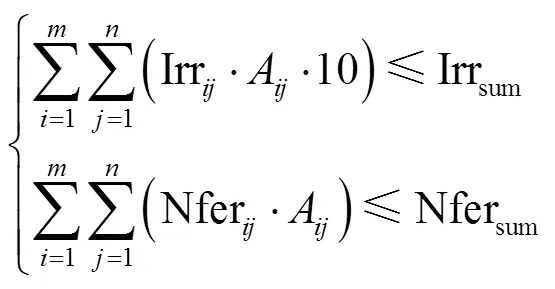
式中Irrsum和Nfersum分别为研究区域种植3种作物所需灌溉总水量m3和总施氮量kg。以《甘肃发展年鉴(1979 —2018)》3种作物总水氮用量最大值为约束上限,设置Irrsum=1.49×109m3,Nfersum=9.7×107kg。
③作物产量约束

式中1sum、2sum和3sum分别为研究区域内制种玉米、大田玉米和小麦的生产下限,kg。基于《甘肃发展年鉴》中的粮食产量数据与《振兴河西国家玉米繁育制种基地实施方案》所提出的玉米种子生产需求,设置1sum、2sum、3sum分别为0.61×109,0.81×109,0.82×109kg。
1.4.2 模型求解方法
模型利用遗传算法求解,通过调用Python 3.9中的scikit-opt程序包实现遗传算法的参数设置与使用。基于已有研究对种植结构优化模型参数的设置[10],本研究中遗传算法的主要参数设置为:种群中规模为为500,最大代数为为1 000,选择方式为比例选择,交叉方式为单点交叉,交叉概率P为0.75,变异概率P为0.01。
2 结果与分析
2.1 APSIM模型的适宜性评价
收集基于河西走廊区域制种玉米[3-4,31-32]、大田玉米[5,28,33-34]和小麦[6,34-36]田间试验发表的学术论文数据(表 1),将数据分为7∶3作为校正集与验证集,对APSIM模型中的作物参数进行校正,参数校正结果与模型验证结果分别如表2和图2所示。收集的数据来自于武威、张掖、玉门和瓜州开展的田间试验,分别位于河西走廊东部、中西部和西部,具有一定的代表性。作物产量的模拟值和实测值2为0.80~0.85、nRMSE为11.0%~15.6%,说明校正的APSIM适于模拟河西走廊区域不同水氮投入下制种玉米、大田玉米和小麦的产量。
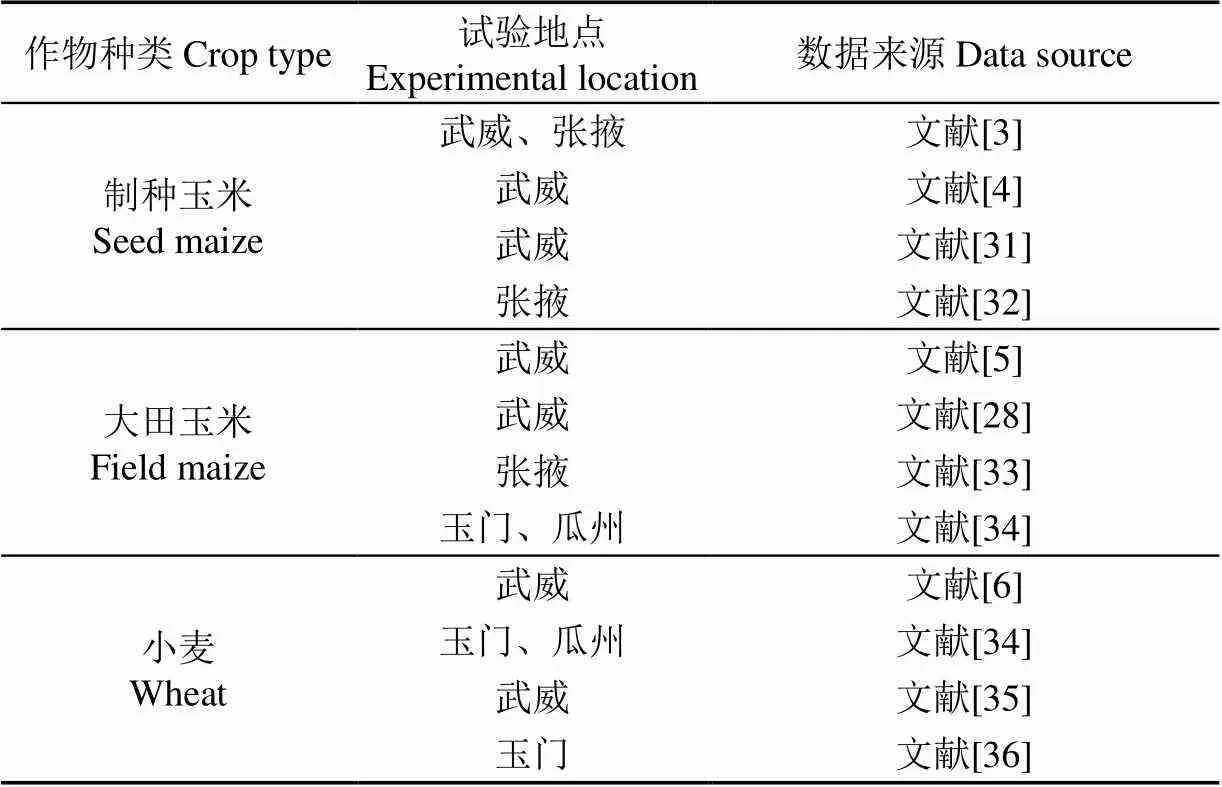
表1 APSIM模型参数校正所用数据来源

表2 制种玉米、大田玉米和小麦的关键参数校正

图2 校正后的APSIM模型对制种玉米、大田玉米和小麦产量的模拟效果
2.2 灌水施氮量优化结果评价
灌水施氮量现状与优化结果如表3所示。对比现状情况,河西走廊制种玉米、大田玉米和小麦的优化灌水量可分别节省22.1%~22.3%、9.1%~17.0%和22.9%~27.3%,施氮量可分别节省32.2%~50.0%、37.5%~44.0%和26.6%~33.6%。综合考虑初始土壤养分和生育期内降雨量优化的水氮管理制度可以明显减少水氮投入量,而在此基础上进行空间尺度上作物种植结构优化,作物产量和水氮利用效率的提升潜力需要进一步量化分析。
2.3 种植结构优化后作物种植空间分布规律
使用APSIM模型模拟传统管理与水氮优化管理2种情景下的作物产量、灌溉水生产力和氮肥利用效率,作为种植结构优化模型的输入数据,优化后作物空间分布与各地区种植面积统计结果分别如图3和表4所示。优化前后3种作物的空间分布存在明显差异(图3):优化后,制种玉米和大田玉米在西部的种植面积减少,在中部和东部的种植面积增加,并集中于酒泉、张掖和武威地区;而小麦在西部区域种植较分散,在中部和东部的种植面积增加,并集中于山丹、永昌和武威地区。对比种植结构优化前后3种作物种植面积(表 4)可以发现,优化后制种玉米和小麦种植面积分别减少1 095.1 hm2(-1.26%)和4 472.1 hm2(-3.07%),而大田玉米种植面积增加692.4 hm2(+0.96%),种植总面积较现状减少4 874.8 hm2。
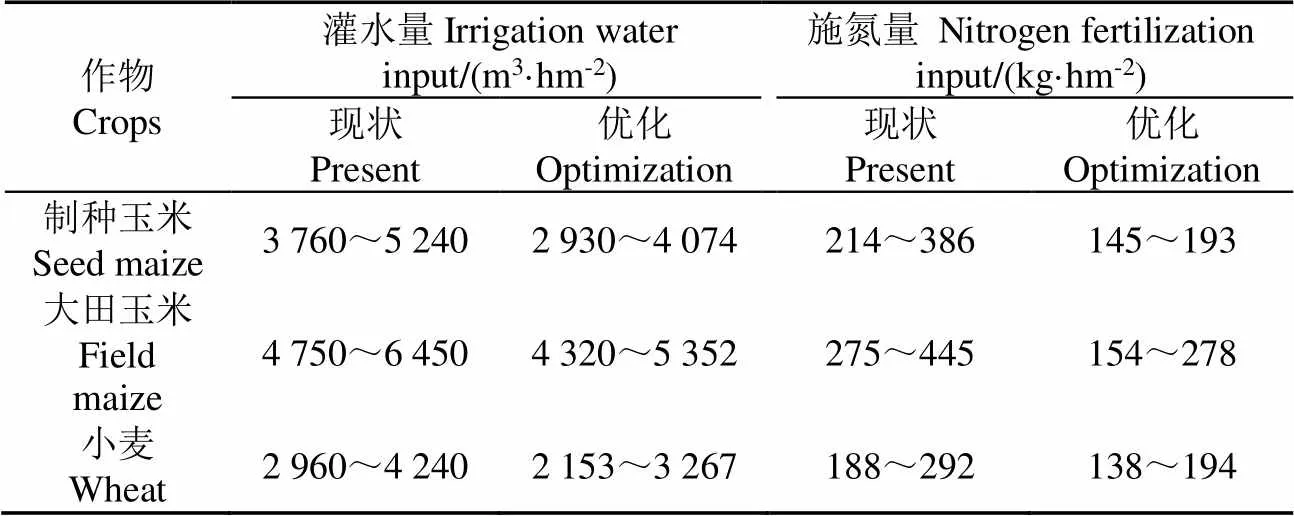
表3 河西走廊制种玉米、大田玉米和小麦单位面积水氮投入量优化与现状
2.4 优化后作物产量与水氮利用效率提升
水氮管理优化、水氮管理与种植结构优化以及现状3种情景下河西走廊制种玉米、大田玉米和小麦的产量、灌溉水生产力、氮肥利用效率和水氮用量计算结果如表 5所示。相比现状,仅施行优化水氮管理制度可使产量提升0.29×108~0.45×108kg(3.6%~6.7%)、灌溉水生产力提升0.44~0.59 kg/m3(22.6%~37.9%)、氮肥利用效率提升11.6~23.2 kg/kg(50.2%~89.0%),灌溉水量减少0.55×108~1.30×108m3(13.6%~24.8%)、施氮量减少1.00×107~1.13×107kg(31.1%~43.5%);而综合水氮管理与种植结构优化可使产量提升0.50×108~0.55×108kg(6.7%~8.1%)、灌溉水生产力提升0.49~0.71 kg/m3(25.1%~46.4%)、水氮肥利用效率提升13.7~24.3 kg/kg(59.6%~93.6%),灌溉水量减少0.59×108~1.42×108m3(14.6%~27.0%)、施氮量减少1.06×107~1.16×107kg(33.1%~44.2%)。
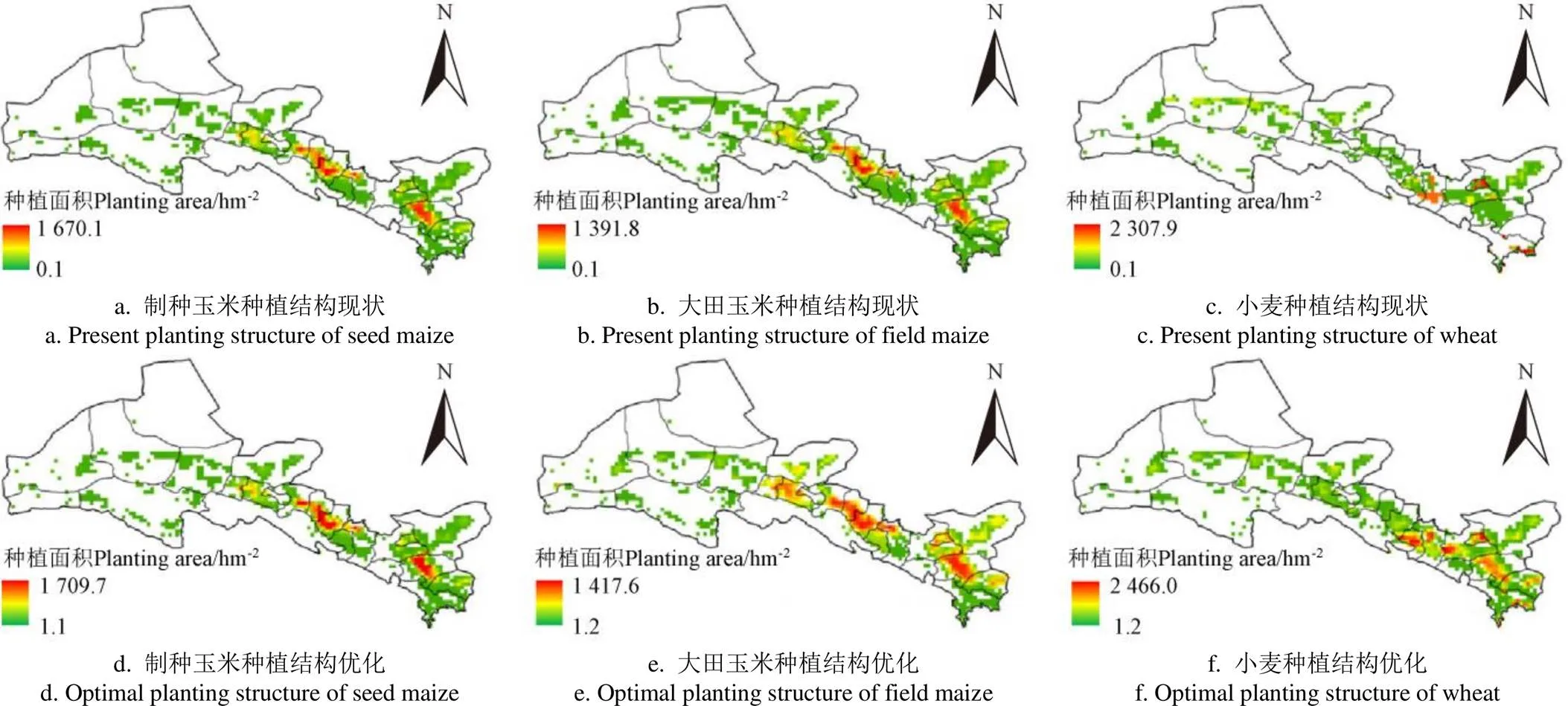
图3 种植结构优化前后廊制种玉米、大田玉米和小麦空间分布

表4 种植结构优化前后河西走廊各市制种玉米、大田玉米和小麦的种植面积

表5 不同管理情景下河西走廊制种玉米、大田玉米和小麦产量、灌溉水生产力、氮肥利用效率和水氮用量
注:INO,水氮管理优化;PSO,种植结构优化。
Note: INO, Optimized irrigation and nitrogen fertilization management; PSO, Optimized planting structure.
河西走廊制种玉米、大田玉米和小麦总产量、水氮总投入量和区域平均水氮利用效率计算结果如表6所示。相比生产和管理现状,实行优化的水氮管理制度可以在产量浮动较小(增产0.12×109kg,约5.4%)的情况下使灌溉水生产力提升0.54 kg/m3(32.1%)、氮肥利用效率提升17.35 kg/kg(68.3%),灌溉水量减少0.27×109m3(20.5%)、施氮量减少3.26×107kg(37.5%);水氮管理与种植结构优化可使产量提升0.16×109kg(7.2%)、灌溉水生产力提升0.62 kg/m3(36.9%)、氮肥利用效率提升18.97 kg/kg(74.7%),灌水量减少0.29×109m3(22.0%)、施氮量减少3.36×107kg(38.6%)。

表6 不同管理情景下河西走廊作物总产量、灌溉水生产力、氮肥利用效率和总水氮用量
3 讨 论
提升作物产量与水氮利用效率是保障粮食安全与农业可持续发展的重要方法,尤其是水资源短缺、农业资源利用效率低、且肩负种子与粮食生产重任的河西走廊地区。针对河西走廊主要种植的作物:制种玉米、大田玉米和小麦,已有许多研究基于田间试验[2-6]与站点模型模拟[7,37]探讨3种作物产量与水氮利用效率协同提升的管理模型。本文在收集的田间试验数据和模型模拟的基础上,通过评估区域尺度不同作物的耗水量、吸氮量,考虑降雨和土壤含氮量的时空变异特征,为河西走廊制种玉米、大田玉米和小麦在区域上优化了水氮管理制度,根据作物需求精准控制水氮投入量,是保证作物产量、提升水氮利用效率的关键,降低水分渗漏与氮素淋失风险。
在区域尺度优化种植结构可以解决区域协调发展问题,是减少农业资源使用量、提升资源利用效率的重要途径[38]。Tan等[39]基于多目标鲁棒模糊优化法对河西走廊区域内的民勤县小麦、玉米、棉花、向日葵、瓜类和蔬菜进行种植结构优化,实现了经济效益和生态效益的显著提升。彭致功等[13]对北京市大兴区多种作物进行灌溉制度优化与种植结构优化,在不同总灌溉水量控制情况下可以提升农业发展阈值41%~61%,并确定了传统农业与设施农业的合理发展阈值。本文将水氮管理与种植结构优化相结合,相比生产与管理现状,优化后的制种玉米、大田玉米和小麦的种植总面积减少,可供其他作物种植或用于生态修复,并可以提升灌溉水生产力0.62 kg/m3、氮肥利用效率18.97 kg/kg,减少灌溉水量0.29×109m3、施氮量3.36×107kg,同时作物产量增加0.16×109kg。种植结构调整将重分配作物的种植区域与面积,扩大综合效益高的区域、缩减效益低的区域,可以实现水氮管理优化方案下的产量与水氮利用效率的进一步提升。相比目前农户与农场过量投入农业资源以追求高产的低效管理模式,本研究提出的水分和氮素精准管理、种植结构因地制宜是保障作物高产并减少水氮投入的关键,从而实现种子、粮食产粮与农业水氮利用效率的协同提升。
4 结 论
1)在维持河西走廊区域作物种植现状情况下,综合考虑土壤含氮量和作物生育期内降雨量对水氮管理制度进行优化,相比水氮管理现状,可使制种玉米、大田玉米和小麦的单位面积灌水量分别减少22.1%~22.3%、9.1%~17.0%和22.9%~27.3%,单位面积施氮量分别减少32.2%~50.0%、37.5%~44.0%和26.6%~33.6%。
2)种植结构优化改变了作物的空间分布与种植面积,优化后河西走廊制种玉米和小麦的种植面积分别减少1 095.1 hm2和4 472.1 hm2,大田玉米种植面积增加692.4 hm2,总种植面积减少4 874.8 hm2。
3)仅实行优化的水氮管理制度可以使灌溉水生产力提升0.54 kg/m3、氮肥利用效率提升17.35 kg/kg、产量提升0.12×109kg,灌溉水量减少0.27×109m3、施氮量减少3.26×107kg;水氮管理与种植结构优化协同作用相比生产与管理现状,可以使灌溉水生产力提升0.62 kg/m3、氮肥利用效率提升18.97 kg/kg、产量提升0.16×109kg,灌水量减少0.29×109m3、施氮量减少3.36×107kg。水氮管理与种植结构优化协同作用可以协同保障河西走廊制种玉米、大田玉米和小麦的生产,并为其他作物种植或生态修复提供可利用空间。
[1] Li S E, Kang S Z, Zhang L, et al. Ecosystem water use efficiency for a sparse vineyard in arid northwest China[J]. Agricultural Water Management, 2015, 148(148): 24-33.
[2] 周奇,王凤新,赵妍,等. 西北旱区膜下滴灌的水氮管理及种植密度对制种玉米生长的影响[J]. 中国农学通报,2016,32(21):166-173.
Zhou Qi, Wang Fengxin, Zhao Yan, et al. Influence of water and nitrogen management and planting density on seed maize growth under drip irrigation with mulch in arid region of northwest China[J]. Chinese Agricultural Science Bulletin, 2016, 32(21): 166-173. (in Chinese with English abstract)
[3] 赵建华. 河西绿洲灌区制种玉米种子生产的水氮效应[D]. 兰州:甘肃农业大学,2016.
Zhao Jianhua. Effects of Irrigation and Nitrogen Fertilizer on Corn for Seed Production in Hexi corridor [D]. Lanzhou: Gansu Agricultural University, 2016. (in Chinese with English abstract)
[4] Ran H, Kang S Z, Li F S, et al. Responses of water productivity to irrigation and N supply for hybrid maize seed production in an arid region of Northwest China[J]. Journal of Arid Land, 2017, 9(4): 504-514.
[5] Xiao C, Zou H Y, Fan J L, et al. Optimizing irrigation amount and fertilization rate of drip-fertigated spring maize in northwest China based on multi-level fuzzy comprehensive evaluation model[J]. Agricultural Water Management, 2021, 257: 107157.
[6] Yang J, Mao X M, Wang K, et al. The coupled impact of plastic film mulching and deficit irrigation on soil water/heat transfer and water use efficiency of spring wheat in Northwest China[J]. Agricultural Water Management, 2018, 201: 232-245.
[7] Li J, Song J, Li M, et al. Optimization of irrigation scheduling for spring wheat based on simulation-optimization model under uncertainty[J]. Agricultural Water Management, 2018, 208: 245-260.
[8] 程谊,张金波,蔡祖聪. 气候-土壤-作物之间氮形态契合在氮肥管理中的关键作用[J]. 土壤学报,2019,56(3):507-515.
Cheng Yi, Zhang Jinbo, Cai Zucong. Key Role of matching of crop-specific N preference, soil N transformation and climate conditions in soil N nutrient management[J]. Acta Pedologica Sinica, 2019, 56(3): 507-515. (in Chinese with English abstract)
[9] 李睿环,郭萍. 黑河中游种植结构优化的双层多目标规划模型[J]. 中国科技论文,2017,12(7):733-737.
Li Ruihuan, Guo Ping. Optimization of bi-level multi-objective planning model for cropping structures in the middle reaches of Heihe River basin[J]. China Sciencepaper, 2017, 12(7): 733-737. (in Chinese with English abstract)
[10] 王璐,杜雄,王荣,等. 基于NSGA-Ⅱ算法的白洋淀上游种植结构优化[J]. 中国生态农业学报,2021,29(8):1370-1383.
Wang Lu, Du Xiong, Wang Rong, et al. Optimization of the planting structure in the upstream region of Baiyangdian Lake based on the non-dominated sorting genetic algorithm (NSGA-Ⅱ)[J]. Chinese Journal of Eco-Agriculture, 2021, 29(8): 1370-1383. (in Chinese with English abstract)
[11] 李彦彬,马嘉彤,李道西,等. 改进粒子群算法在农业种植结构优化中的应用[J]. 灌溉排水学报,2022,41(1):62-71.
Li Yanbin, Ma Jiatong, Li Daoxi, et al. An improved particle swarming optimization method to optimize cropping systems[J]. Journal of Irrigation and Drainage, 2022, 41(1): 62-71. (in Chinese with English abstract)
[12] Liu Q, Niu J, Wood J D, et al. Spatial optimization of cropping pattern in the upper-middle reaches of the Heihe River basin, Northwest China[J]. Agricultural Water Management, 2022, 264: 107479.
[13] 彭致功,张宝忠,刘钰,等. 基于灌溉制度优化和种植结构调整的用水总量控制[J]. 农业工程学报,2018,34(3):103-109.
Peng Zhigong, Zhang Baozhong, Liu Yu, et al. Constraint of total water consumption amount based on optimized irrigation schedule and planting structure ajustment[J]. Transactions of the Chinese Society of Agricultural Engineering (Transactions of the CSAE), 2018, 34(3): 103-109. (in Chinese with English abstract)
[14] Yang K, He J, Tang W J, et al. On downward shortwave and longwave radiations over high altitude regions: Observation and modeling in the Tibetan Plateau[J]. Agricultural and Forest Meteorology, 2010, 150(1): 38-46.
[15] Fischer G, Shah M, van Velthuizen H, et al. Global Agro-ecological Zones Assessment for Agriculture (GAEZ 2008)[M]. Rome, Italy: FAO, 2008
[16] Yu Q Y, You L Z, Wood-Sichra U, et al. A cultivated planet in 2010 – Part 2: The global gridded agricultural-production maps[J]. Earth System Science Data, 2020, 12(4): 3545-3572.
[17] Lin W Q, Chen H P. Daily snowfall events on the Eurasian continent: CMIP6 models evaluation and projection[J/OL]. International Journal of Climatology, 2022-03-24[2022-08-04]. https://doi.org/10.1002/joc.7618
[18] Buis S, Lecharpentier P, Vezy R. CroptimizR: A Package for Parameter Estimation, Uncertainty and Sensitivity Analysis for Crop Models (Version 0. 4. 0)[Z]. Avignon, France: National Research Institute for Agriculture, Food and Environment, 2021.
[19] Kang S Z, Hao X M, Du T S, et al. Improving agricultural water productivity to ensure food security in China under changing environment: From research to practice[J]. Agricultural Water Management, 2017, 179: 5-17.
[20] 宋子奕,鲁程鹏,吴成城,等. 2009—2019年河西走廊地下水位时空分布及演变趋势研判[J/OL]. 水资源保护,2022-05-20. [2022-09-18]. http: //kns. cnki. net/kcms/detail/32. 1356. TV. 20220519. 1709. 014. html
Song Ziyi, Lu Chengpeng, Wu Chengcheng, et al. Spatiotemporal distribution and evolution trend of groundwater level in Hexi Corridor from 2009 to 2019[J/OL]. Water Resources Protection, 2022-05-20. [2022-09-18]. http: //kns. cnki. net/kcms/detail/32. 1356. TV. 20220519. 1709. 014. html. (in Chinese with English abstract)
[21] Allen R G, Pereira L S, Raes D, et al. Crop Evaporation: Guidelines for Computing Crop Water Requirements[M]. Rome, Italy: FAO, 1998.
[22] 李波,景竹然,魏新光,等. 东北地区春玉米作物系数时空分布特征研究[J]. 农业机械学报,2020,51(4):279-290.
Li Bo, Jing Zhuran, Wei Xinguang, et al. Spatial and temporal distribution characteristics of spring maize coefficients in northeast China[J]. Transactions of the Chinese Society for Agricultural Machinery, 2020, 51(4): 279-290. (in Chinese with English abstract)
[23] Jiang X L, Kang S Z, Tong L, et al. Crop coefficient and evapotranspiration of grain maize modified by planting density in an arid region of northwest China[J]. Agricultural Water Management, 2014, 142: 135-143.
[24] Priestley C H B, Taylor R J. On the assessment of surface heat flux and evaporation using large-scale parameters[J]. Monthly Weather Review, 1972, 100(2): 81-92.
[25] 顾贺. 甘肃农业灌溉水有效利用系数测算分析研究[J]. 甘肃科技,2015,31(24):49-50.
[26] Liang H, Gao S J, Hu K L. Global sensitivity and uncertainty analysis of the dynamic simulation of crop N uptake by using various N dilution curve approaches[J]. European Journal of Agronomy, 2020, 116: 126044.
[27] 蔡甲冰,常宏芳,陈鹤,等. 基于不同有效积温的玉米干物质累积量模拟[J]. 农业机械学报,2020,51(5):263-271.
Cai Jiabing, Chang Hongfang, Chen He, et al. Simulation of maize dry matter accumulation in normalized logistic model with different effective accumulated temperatures in field[J]. Transactions of the Chinese Society for Agricultural Machinery. 2020, 51(5): 263-271. (in Chinese with English abstract)
[28] 闵迪,王增红,李援农,等. 不同灌水和施氮水平对河西春玉米水氮利用效率和经济效益的影响[J]. 干旱地区农业研究,2020,38(5):153-160.
Min Di, Wang Zenghong, Li Yuannong, et al. Effects of different irrigation and nitrogen application levels on the yield and water and nitrogen use efficiency of spring maize[J]. Agricultural Research In the Arid Areas, 2020, 38(5): 153-160. (in Chinese with English abstract)
[29] 张忠学,刘明,齐智娟. 不同水氮管理模式对玉米地土壤氮素和肥料氮素的影响[J]. 农业机械学报,2020,51(2):284-291.
Zhang Zhongxue, Liu Ming, Qi Zhijuan. Effects of different water and nitrogen managements on soil nitrogen and fertilizer nitrogen in maize field[J]. Transactions of the Chinese Society for Agricultural Machinery, 2020, 51(2): 284-291. (in Chinese with English abstract)
[30] Lalehzari R, Boroomand N S, Moazed H, et al. Multiobjective management of water allocation to sustainable irrigation planning and optimal cropping pattern[J]. Journal of Irrigation and Drainage Engineering, 2016, 142(1): 5015008.
[31] Wang Y F, Kang S Z, Li F S, et al. Modified water-nitrogen productivity function based on response of water sensitive index to nitrogen for hybrid maize under drip fertigation[J]. Agricultural Water Management, 2021, 245: 106566.
[32] 连彩云,马忠明. 水肥用量对制种玉米水肥利用及种子活力的影响[J]. 干旱地区农业研究,2021,39(1):128-135.
Lian Caiyun, Ma Zhongming. Rates of water and fertilizer on their use efficiency and seed vigor of seed maize[J]. Agricultural Research in the Arid Areas, 2021, 39(1): 128-135. (in Chinese with English abstract)
[33] 张鹏,张富仓,吴立峰,等. 不同灌水和施氮对河西绿洲春玉米生长、产量和水分利用的影响[J]. 干旱地区农业研究,2011,29(4):137-143.
Zhang Peng, Zhang Fucang, Wu Lifeng, et al. Effect of different irrigation and nitrogen fertilizer on spring maize growth, yield and water use[J]. Agricultural Research in the Arid Areas, 2011, 29(4): 137-143. (in Chinese with English abstract)
[34] 何巧凤. 疏勒河流域中下游地区农作物水足迹影响因素分析及预测[D]. 太原:山西师范大学,2021.
He Qiaofeng. Analysis of Influencing Factors and Prediction of Crop Water Footprint in the Middle and Lower Reaches of the Shule River Basin[D]. Taiyuan: Shanxi Normal University, 2021. (in Chinese with English abstract)
[35] 吴立峰,张富仓,张鹏,等. 灌水和施氮对甘肃河西绿洲春小麦生长及产量的影响[J]. 西北农林科技大学学报(自然科学版),2011,39(7):55-63.
Wu Lifeng, Zhang Fucang, Zhang Peng, et al. Effect of irrigation and nitrogen fertilizer on growth and yield of spring wheat in Hexi oasis of Gansu[J]. Journal of Northwest A & F University (Natural Science Edition), 2011, 39(7): 55-63. (in Chinese with English abstract)
[36] 彭锋. 玉门市绿洲平原生态区小麦测土配方施肥试验[J]. 甘肃农业科技,2016(2):33-35.
[37] Chen S C, Wang S F, Shukla M K, et al. Delineation of management zones and optimization of irrigation scheduling to improve irrigation water productivity and revenue in a farmland of Northwest China[J]. Precision Agriculture, 2020, 21(3): 655-677.
[38] 吴炳方,曾红伟,陈曦. 基于空间认知的“丝绸之路经济带”耕地利用模式[J]. 中国科学院院刊,2016,31(5):542-549.
Wu Bingfang, Zeng Hongwei, Chen Xi. Spatial cognition on cultivated land utilization pattern of the silk road economic belt[J]. Bulletin of the Chinese Academy of Sciences, 2016, 31(5): 542-549. (in Chinese with English abstract)
[39] Tan Q, Zhang S, Li R. Optimal Use of Agricultural Water and Land Resources through Reconfiguring Crop Planting Structure under Socioeconomic and Ecological Objectives[J]. Water, 2017, 9(7): 488.
Achieving high-yield and high-efficient management strategy based on optimized irrigation and nitrogen fertilization management and planting structure
Chen Shichao, Liu Wenfeng, Du Taisheng※
(1.,,100083,; 2.,733000,)
The Hexi Corridor is an important production base of maize seed and commodity grain in China. The ample sunshine and temperature greatly contribute to crop production in sustainable agriculture. However, the shortage of water resources has posed a serious threat to the efficiency of resource utilization. An adaption strategy can be expected to promote crop yield and resource use efficiency in changing environments, including the optimization of management measures and the adjustment of planting structure. Taking the seed maize, field maize, and wheat as the research objects, this study aimed to optimize the irrigation and nitrogen fertilization in the crop planting structure, in order to comprehensively improve the crop yield, irrigation Water Productivity (WPI), and Nitrogen Use Efficiency (NUE). An Agricultural Production Systems sIMulator (APSIM) model was also calibrated to evaluate the optimization using the simulations. The field experimental data was collected from the different stations over several years. The profile of seed maize was established for the crop type. The key parameters of field maize and wheat were calibrated in the APSIM. There was the high accuracy of calibrated APSIM model (0.80 <2< 0.85, 11.0% < normalized Root Mean Square Error (nRMSE) < 15.6%), indicating the better applicability of APSIM simulation for the seed maize, field maize, and wheat. The optimization module of irrigation was taken the single crop coefficient as the key component, considering the precipitation during the crop growth period. The optimization module of nitrogen fertilization selected the crop nitrogen concentration and biomass accumulation curve as the important components, in order to jointly constitute the irrigation nitrogen application for the optimization framework. The optimal inputs of irrigation water and nitrogen fertilization were reduced evidently. The irrigation water amount of seed maize, field maize, and wheat was saved by 22.1%-22.3%, 9.1%-17.0%, and 22.9%-27.3%, respectively, and the nitrogen application amount was saved by 32.2%-50.0%, 37.5%-44.0%, and 26.6%-33.6%, respectively, compared with the present. The objective functions included the maximum crop yield, WPI, and NUE in the optimization of crop planting structure. The boundary constraints included the total crop planting area, crop yield demand, as well as irrigation water and nitrogen fertilization input. The planting areas of seed maize and wheat after optimization were reduced by 1 095.1 and 4 472.1 hm2, respectively. By contrast, the planting area of field maize increased by 692.4 hm2. The total planting area was reduced by 4 874.8 hm2. There was a significant difference in the spatial distribution of crop planting after optimization. The total crop production, WPI, and NUE increased by 0.12×109kg, 0.54 kg/m3, and 17.35 kg/kg, respectively, whereas, the irrigation water and nitrogen fertilization inputs decreased by 0.27×109m3and 3.26×107kg, respectively, under the optimization of the irrigation and nitrogen fertilization. After the optimization of irrigation, nitrogen fertilization, and the crop planting structure, the total crop production, WPI, and NUE increased by 0.16×109kg, 0.62 kg/m3, and 18.97 kg/kg, respectively, whereas, the irrigation water and nitrogen fertilization inputs decreased by 0.29×109m3and 3.36×107kg, respectively. The finding can provide scientific guidance and reference for the high-efficient and high-yield crop production in sustainable agriculture in areas with the major grain-producing and water shortages.
crop; irrigation; optimization; planting structure; irrigation and nitrogen fertilization management; irrigation water productivity; nitrogen use efficiency
10.11975/j.issn.1002-6819.2022.16.016
S274
A
1002-6819(2022)-16-0144-09
陈世超,刘文丰,杜太生. 基于水氮管理与种植结构优化的作物丰产高效管理策略[J]. 农业工程学报,2022,38(16):144-152.doi:10.11975/j.issn.1002-6819.2022.16.016 http://www.tcsae.org
Chen Shichao, Liu Wenfeng, Du Taisheng. Achieving high-yield and high-efficient management strategy based on optimized irrigation and nitrogen fertilization management and planting structure[J]. Transactions of the Chinese Society of Agricultural Engineering (Transactions of the CSAE), 2022, 38(16): 144-152. (in Chinese with English abstract) doi:10.11975/j.issn.1002-6819.2022.16.016 http://www.tcsae.org
2022-07-04
2022-08-14
国家自然科学基金项目(51725904、51861125103、52109071)
陈世超,博士后,研究方向为节水灌溉理论与新技术。Email:chenshichaocsc@cau.edu.cn
杜太生,博士,教授,研究方向为农业节水与水资源高效利用。Email:dutaisheng@cau.edu.cn

